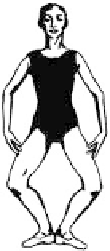Environmental Engineering Reference
In-Depth Information
But what of the reverse process? Can disordered thermal motion spontaneously
be transformed into ordered motion? Is it possible that the stone and the sand can
spontaneously cool down, delivering the thermal energy back to the stone causing it
to leap into the air? Such a bizarre happening is clearly contrary to our experience,
but it is not impossible. It is just very unlikely to happen if the original mechanical
energy is dissipated randomly.
Real systems of many constituent particles may be rigid, as is the case of a
steel block, or they may be more fluid and deformable like a piece of plasticine.
A little care is required when using energy conservation with deformable systems
as it is often the case that the internal forces may dissipate kinetic energy into
thermal energy. In addition, it is possible for a complex, deformable, system to
convert internal potential energy into kinetic energy. An explosion provides a good
example of the latter process at work. It is also the case with the following example
of a ballerina's saute.
Example 3.4.1
Discuss which forces do the work when a ballerina sautes (jumps)
into the air. In particular, explain why the normal reaction from the ground does
no work.
Solution 3.4.1
It is quite sensible to first draw the free body diagrams illustrated
in the dotted boxes in Figure 3.12. Figure 3.12(a) refers to the period of the jump
m
g
N
F
dx
m
g
m
g
N = F
−
F
(a)
(b)
Figure 3.12 Diagram showing the mechanics of a ballerina's saute: (a) the
upwards-acceleration phase of the jump, illustrating the forces on the feet and the body;
(b) the jump phase, when the acceleration is downwards. Free-body diagrams, in which the
internal forces are ignored, are enclosed in dotted boxes.
















